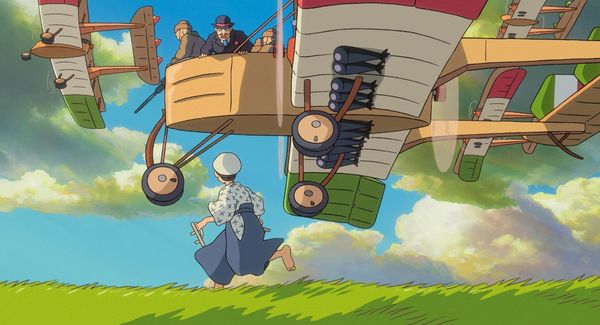Eye For Film >> Movies >> The Wind Rises (2013) Film Review
The Wind Rises
Reviewed by: Anne-Katrin Titze

Literature and aviation are the stuff that dreams are made of in Hayao Miyazaki’s poetic spectacular The Wind Rises (Kaze Tachinu).
The title of the film is taken from the novel by Tatsuo Hori, who pulled a line from Paul Valéry's poem Le Cimetière Marin (The Graveyard By The Sea).

"Le vent se lève! . . . il faut tenter de vivre!" - "The wind is rising...we must try to live", guides the hero. Scorching pink and chartreuse clouds request the pleasure of our company in Miyazaki's "temple of time", begotten at the horizon.
The film starts factually and figuratively with a childhood dream - young Jiro Horikoshi, based in part on the man who will later design the famed Zero Fighter, has a plane on his roof. It looks like a pale bird with blue fingerly feathery wings, and he flies with it into the skies where he encounters a sinister war plane that carries bombs on ropes dangling from it like a school of ravenous fish. Jiro falls from the sky and out of the dream.
This animation is not being marketed as a children's film because of its subject matter: war, the construction of death-bringing fighter planes, the Great Kanto Earthquake of 1923 in Japan, famine, poverty, destruction, and the tuberculosis epidemic. Yet Miyazaki's canon, including his latest film, is acutely optimistic and shares a classic definition with the fairy tale. Its "one-dimensionality" makes all realms of existence equal and bright. Dream and waking life are on impartial standing. The realities of the Great Depression and Hitler's Germany are interwoven with time-traveling meetings, colleague to colleague, between Jiro and his boyhood hero, Italian aeronautical engineer Gianni Caproni. The two wonder whose dream they are meeting in. "You think we are sharing this dream?" one of them says. The dream they do share is of a time when the wars will be over and their inventions will be used for passenger planes.
Miyazaki, whose father worked in aviation, has always been a sovereign in telling stories of flight. Howl's Moving Castle (2004), Kiki's Delivery Service (1989), Porco Rosso (1992), and Nausicaä of the Valley of the Wind (1984) have the sky as their limit. The incomparable My Neighbor Totoro (1988) and Ponyo (2008), his climate change adapted Little Mermaid, turn forest and ocean into substitutes for sky travel.
The Wind Rises is also a love story. Jiro meets Naoko first on a fateful train ride, when a gust of wind carries his hat away for her to catch. A second meeting, years later, mirrors the scene and the same wise and playful wind lifts away her parasol in the mountains for him to catch and return the initial interception. The moment reminded me of what, unbeknown to me until now, had been my very first encounter with Hayao Miyazaki's work in the art department for the TV series Heidi, which I loved as a child.
With the phrase that sounded phonetically like "nice-a-catchy!" when the couple in the The Wind Rises bond again over a paper plane they seal their love. A moment that shows him working while holding her hand is one of the most careful and intimate expressions of a relationship I have seen in quite some time.
Jiro is an impassioned action hero, who stands up to bullies and more than once shows what a fine man he is.
The sanatorium scenes in the film rely formidably on Thomas Mann's novel The Magic Mountain, published in 1924. A German character named Castorp and a visualisation of Mann's superb description of the art of wrapping yourself in a camel-hair blanket on the balcony of the Davos sanatorium find their way into the film. Lodovico Settembrini might have inspired dream pal Caproni and the overall tentative and lighthearted play with the Bildungsroman, makes Miyazaki and Mann a great fluent team.
The earthquake starts with quivering pebbles, human sounding growling echoes of the earth, fire clouds and billows in yellow and gray bring destruction. Jiro helps an injured woman, doesn't hesitate or waver. The man, whose planes will bring abstract death is courageous face-to-face. Miyazaki asks the difficult questions about proximity and responsibility.
Jiro loves shapes and a mackerel bone's beautiful curve from "the faithful sea" inspirits a plane construction.
Miyazaki's films for children stand out for their marvellous small and strong female characters in the lead, who often come with an unidentified even smaller animal sidekick who shares their disdain, sense of justice, and willingness to travel far.
The Wind Rises has Jiro's little sister become a doctor. She embodies the qualities of the filmmaker's past heroines, even without the mini-animal deputy support.
At the Mitsubishi engine company, the hero's integrity is being tested. Past and present are one in Japan as oxen haul the latest aircraft onto the runway. On a business trip Jiro visits Germany, where he walks on purple cobblestones and listens to Schubert's Winterreise floating out through a nightly window. His hotel room gives a half-obscured glimpse of Böcklin's painting of the Isle of the Dead. Blink and you miss it, such are the fleeting references in Miyazaki's work. If a house has chicken legs, as one did in Howl's Moving Castle, it doesn't necessarily mean that a cannibalistic Baba Yaga has to live in it.
Brown pulp and yellow hell clouds of desolation reign over the cemetery of shot-down fighter planes. Not a single plane returned. You must live.
Miyazaki's films linger for a long time, they can't be pinned down, their meaning won't dissolve on the horizon. See it at the New York Film Festival in the original Japanese version with English subtitles.
Miyazaki's The Wind Rises doesn't miss a beat.
Reviewed on: 21 Sep 2013














